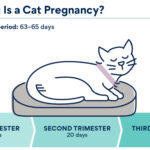Cats With Black And White coats are a common and captivating sight, easily spotted gracing homes and shelters alike. While solid black cats might be statistically more frequent, the striking contrast of black and white fur is readily observed across numerous breeds and mixed breeds.
However, a black and white coat is more than just a color combination; it’s a fascinating window into feline genetics. While coat color alone won’t pinpoint a breed, the interplay of black and white hues reveals intriguing details about a cat’s genetic makeup. Closer examination reveals a spectrum of patterns, each uniquely distributing these contrasting colors across the feline form.
The world of black and white cats is rich and varied. Let’s explore the different patterns that define these bicolored beauties.
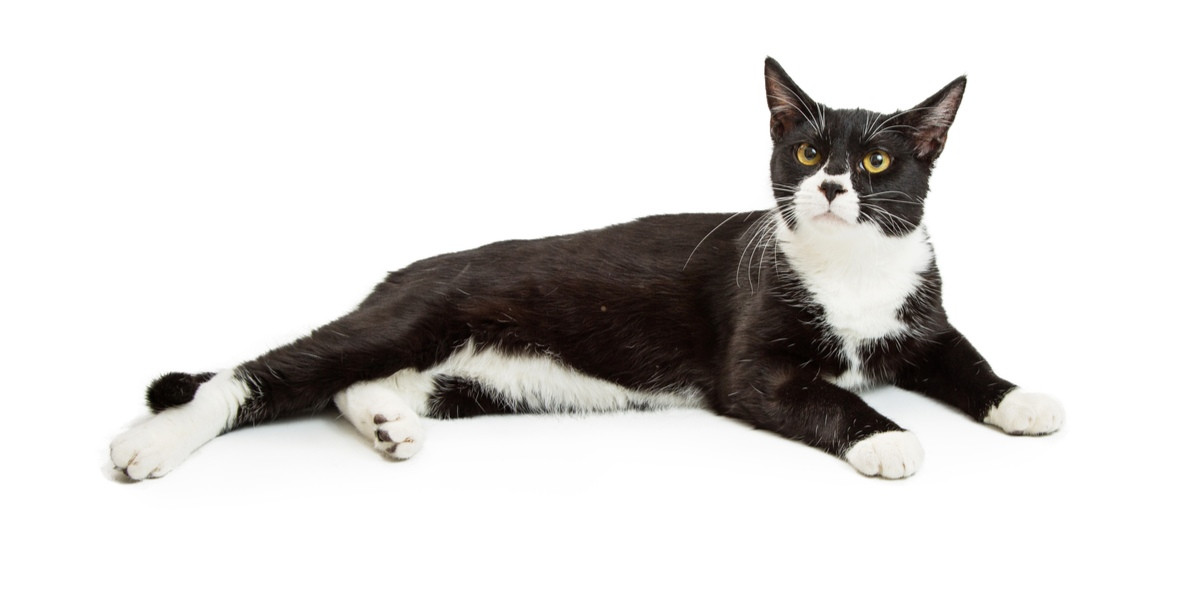 A striking black and white cat with a focused gaze, showcasing the classic bicolor pattern.
A striking black and white cat with a focused gaze, showcasing the classic bicolor pattern.
Understanding Bicolor Cats: Key Facts
All cats exhibiting both black and white fur fall under the bicolor, or piebald, category. This broad classification encompasses any cat with a base color combined with white markings. Alongside black, common base colors include gray, cream, and brown. The term “piebald” isn’t exclusive to cats, also describing similar patterns in animals like horses, birds, pigs, and even snakes.
Genetics dictate these captivating black and white bicolor patterns. Their presence hinges on inheriting at least one allele of the “white spotting gene.” This gene exhibits incomplete dominance, meaning its expression varies depending on the combination of dominant and recessive alleles passed down from parents.
Two dominant white spotting alleles typically result in extensive white fur, often covering over half the cat’s body. Conversely, a mix of one dominant and one recessive allele usually leads to a more balanced distribution of black and white fur.
Classifying bicolor patterns involves a degree of subjectivity. To standardize this, feline experts have developed a “white spotting scale.”
- Low-grade: Less than 40% white fur.
- Medium-grade: 40%-60% white fur.
- High-grade: More than 60% white fur.
The Cat Fanciers Association employs a similar scale from 1 to 10, where 1 indicates no white spotting and 10 represents a completely white cat.
Interestingly, there’s a general trend linking the white spotting scale to the location of white fur. Lower-grade patterns often feature white markings confined to the chest or belly. As the grade increases, white fur tends to spread, initially appearing on the front paws, then progressing to the sides, and finally extending to the legs and face. While this provides a general guideline, it’s not an inflexible rule.
While bicolor cats are readily found in shelters, breeders also strategically plan matings to produce kittens with specific black and white patterns. Breeds like the Turkish Van, British Shorthair, American Shorthair, Manx, and Turkish Angora all recognize bicolor coat patterns within their breed standards.
Unveiling Black and White Cat Coat Patterns
Predicting a kitten’s exact coat pattern remains an inexact science, as various genes influence the final bicolor presentation. Distinguishing between different black and white patterns can be nuanced, but here’s a breakdown of the most recognized markings:
1. Locket Pattern
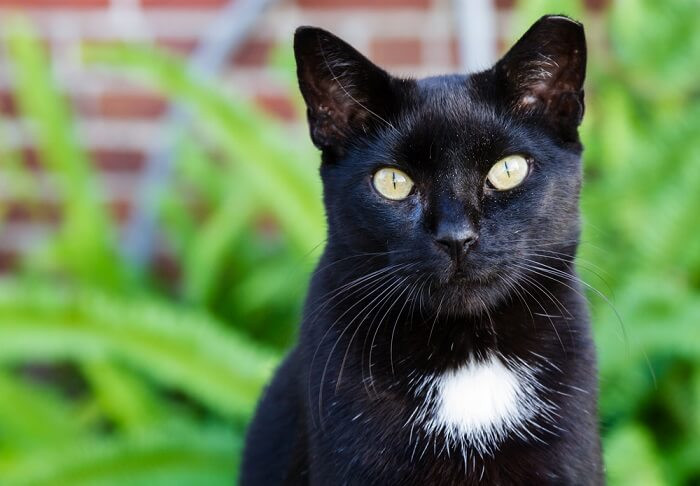 A charming black and white cat with a locket pattern, featuring a small white patch on its chest.
A charming black and white cat with a locket pattern, featuring a small white patch on its chest.
Falling into the low-grade category on the white spotting scale, the locket pattern is characterized by a small, distinct patch of white fur. This patch can manifest as a spot, streak, or more irregular shape, predominantly located on the cat’s chest.
This marking gives the impression of a delicate locket necklace adorning the cat. A similar small white marking on the stomach might also be classified as a locket pattern.
2. Tuxedo Pattern
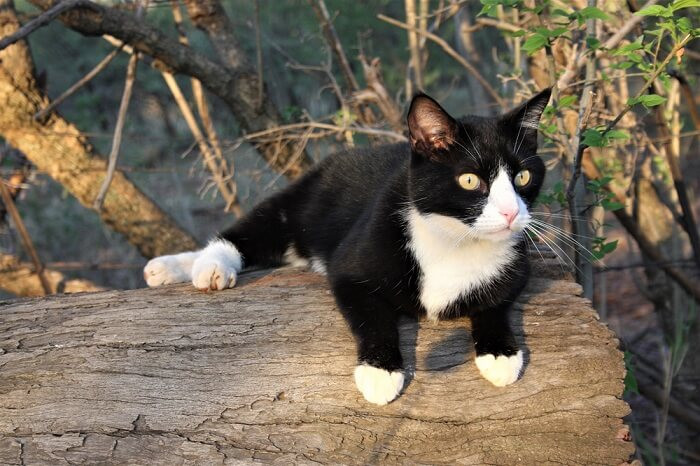 An elegant tuxedo cat in black and white, showcasing the classic formal attire pattern.
An elegant tuxedo cat in black and white, showcasing the classic formal attire pattern.
Tuxedo cats are arguably the most recognizable and beloved among black and white felines. Their distinctive pattern features white fur on the chest, belly, and paws, creating the illusion of formal wear.
Often, tuxedo cats also sport white markings on their face. It’s important to remember that the “tuxedo” designation isn’t limited to black and white cats. Tuxedo cats can also be gray and white, and even tabby cats can exhibit this elegant pattern.
3. True Bicolor Pattern
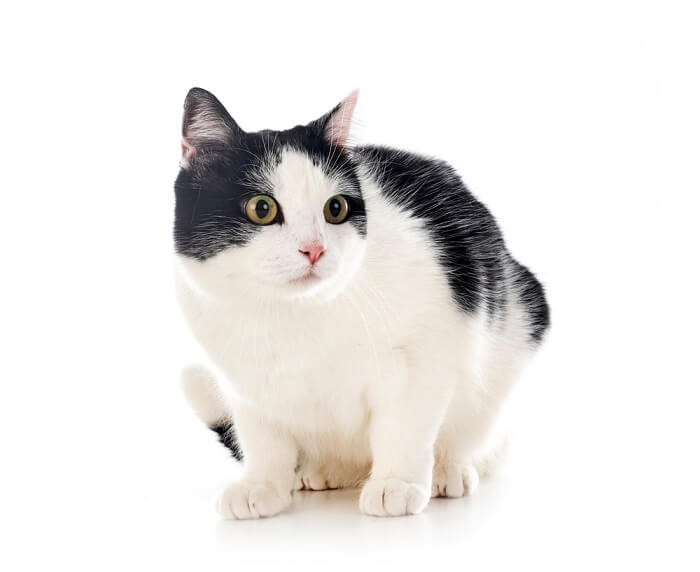 A well-balanced true bicolor cat with an even distribution of black and white patches across its body.
A well-balanced true bicolor cat with an even distribution of black and white patches across its body.
While “bicolor” broadly describes any two-colored cat, the “true bicolor” specifically refers to cats with a near-equal distribution of white fur and their other primary color. These cats fall into the medium-grade category on the white spotting scale. The contrasting colors typically appear in patches, distributed relatively evenly throughout the body.
4. Harlequin Pattern
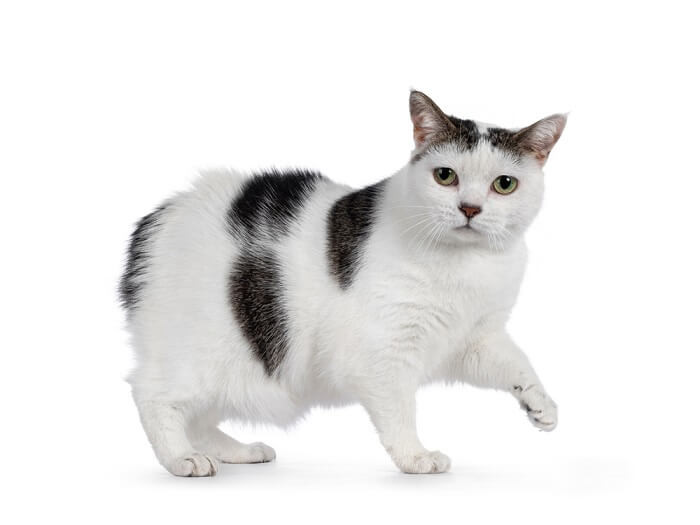 A playful harlequin cat with distinctive, random spots of black scattered across a white base coat.
A playful harlequin cat with distinctive, random spots of black scattered across a white base coat.
Sometimes playfully called “cow cats” or even “Dalmatian cats,” harlequin cats are defined by smaller, randomly scattered spots and patches of color over a predominantly white coat. These spots can be numerous and cover a significant portion of the body, lacking any predictable or uniform arrangement. They differ from the stripes of tabby cats or the large, defined sections seen in tuxedo patterns.
5. Mask and Mantle Pattern
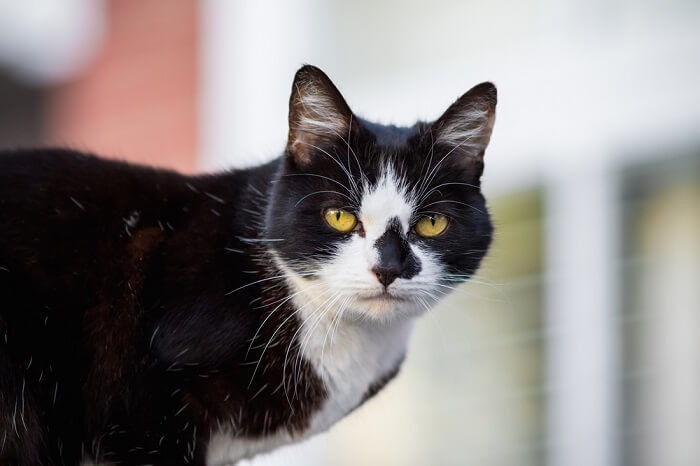 A mysterious mask and mantle cat, with dark fur around its face and a cape-like marking over its shoulders.
A mysterious mask and mantle cat, with dark fur around its face and a cape-like marking over its shoulders.
The mask and mantle pattern describes a specific distribution of color where dark fur encircles the eyes, ears, and forehead, forming a “mask.” The white fur usually begins at the nose and extends down the chin, neck, and chest. This creates a striking resemblance to a masquerade costume. Some cats with this pattern also display a “mantle,” which appears as a colored cape draped over their shoulders and torso. A cat can exhibit either a mask or a mantle, or both in combination.
6. Cap and Saddle Pattern
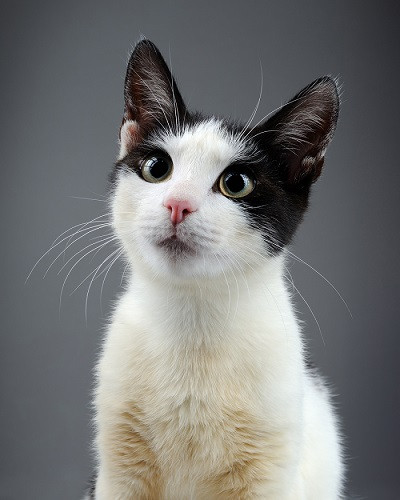 A charming cap and saddle cat, featuring a cap of color on its head and a saddle-like patch on its back.
A charming cap and saddle cat, featuring a cap of color on its head and a saddle-like patch on its back.
The cap and saddle patterns share similarities with the mask and mantle. A “cap” is essentially a smaller mask, a patch of colored fur starting above the eyes and covering the top of the head. A “saddle” is a reduced mantle, a patch of color positioned on the back, resembling a saddle, without extending over the shoulders.
Beyond the Common Patterns
Feline coat patterns are not always rigidly defined, and black and white cats can exhibit markings that don’t neatly fit into the categories above. While less frequent, these variations add to the diversity. The “van” pattern, for instance, is most commonly seen in the Turkish Van breed or cats with Turkish Van ancestry.
Van patterned cats are predominantly white with color restricted to patches on the head and often the tail. “Skunk” cats, another rarer pattern, feature a distinct white stripe running down their spine.
Interestingly, the Cat Fanciers Association also notes that some black and white coat patterns can arise from health conditions. Vitiligo, for example, is a condition causing pigment loss, often manifesting on the feet and face, which can alter a cat’s black and white appearance over time.
Does your feline companion sport a black and white coat? Can you identify their unique pattern?
View Sources
Cats.com utilizes reputable sources, including peer-reviewed studies, to ensure the accuracy of our content. Our articles are regularly reviewed and updated. Visit our About Us page to learn more about our standards and veterinary review board.

